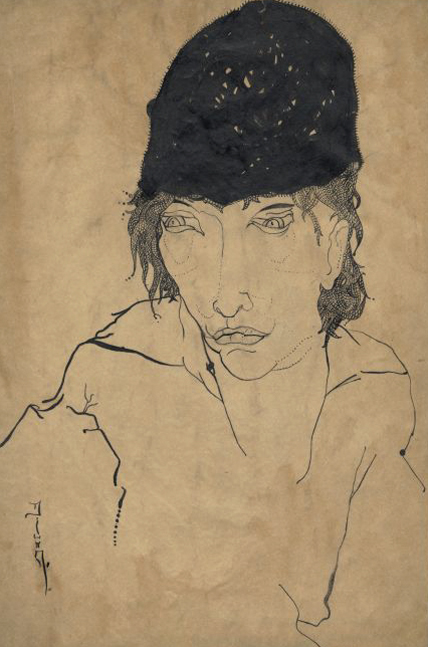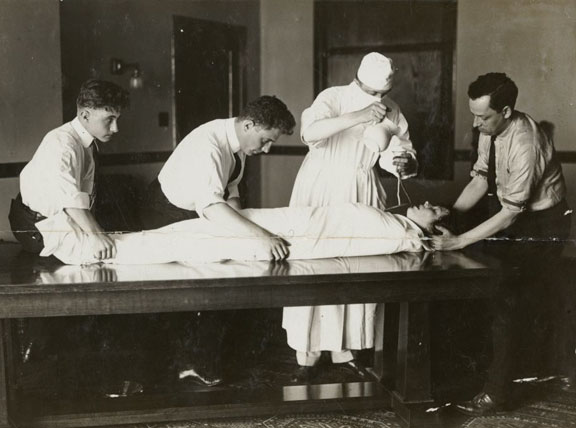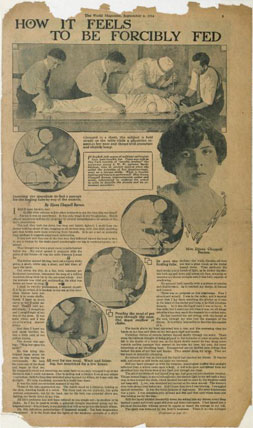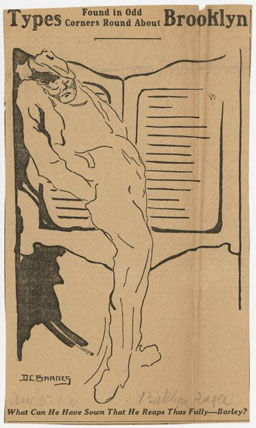
Djuna Barnes (American, 1892–1982), Sketch of a woman with hat, looking right, for “The Terrorists,” New York Morning Telegraph Sunday Magazine, September 30, 1917. Ink on paper, 123⁄4 x 81⁄2 in. (32.4 × 21.6 cm). Djuna Barnes Papers, Special Collections, University of Maryland Libraries

Djuna Barnes (American, 1892–1982), Sketch of a woman with hat, looking right, for “The Terrorists,” New York Morning Telegraph Sunday Magazine, September 30, 1917. Ink on paper, 123⁄4 x 81⁄2 in. (32.4 × 21.6 cm). Djuna Barnes Papers, Special Collections, University of Maryland Libraries

Man with moustache, fisherman’s hat, looking left, for “On Going Fishing,” New York Morning Telegraph Sunday Magazine, July 29, 1917. Ink on paper. Djuna Barnes Papers, Special Collections, University of Maryland Libraries

Djuna Barnes and unidentified fireman, dangling from a rope beside a building, October 1914. Gelatin silver photograph. Djuna Barnes Papers, Special Collections, University of Maryland Libraries
This photograph was taken to accompany “My Adventures Being Rescued,” an article that recounts how Barnes attended a firefighters’ training session and played at being saved three times. While Barnes’s instinct to insert herself into her chosen stories gave her ample opportunity to showcase her courage and evocative prose, it also carried real danger, as demonstrated when a homemade airplane she was to ride in crashed, killing all those aboard.

Djuna Barnes, being forcibly fed, August 16, 1914. Photograph, 81⁄2 x 107⁄8 in. (21.6 × 27.6 cm). Djuna Barnes Papers, Special Collections, University of Maryland Libraries

How it Feels to Be Forcibly Fed,” New York World Magazine, September 6, 1914. Djuna Barnes Papers, Special Collections, University of Maryland Libraries

What can he have Sown…, from the series “Types found in Odd Corners About Brooklyn,” Brooklyn Daily Eagle, August 5, 1913. Djuna Barnes Papers, Special Collections, University of Maryland Libraries

The Doughboy (man with bayonet), cover of Trend magazine, October 1914. Djuna Barnes Papers, Special Collections, University of Maryland Libraries
While the majority of Barnes’s illustrations adopt the sleek graphic style of Art Nouveau, The Doughboy, commissioned for the October 1914 cover of Trend magazine, shows her expressive range and grim identification with the lone figure set against the horrors of the trenches. War had been declared just months earlier, but the searching eyes, hazy background, and unexpected nudity of the soldier emphasize his everyman status and foreshadow the impending carnage of World War I.

Newspaper Fiction: The New York Journalism of Djuna Barnes, 1913–1919
January 20–August 19, 2012
Newspaper Fiction: The New York Journalism of Djuna Barnes, 1913–1919 is an exploration of the early journalistic career of American writer and women’s rights advocate Djuna Barnes. Though best known for her modernist novels and plays, including Nightwood (1936) and The Antiphon (1958), Barnes spent the period between 1913 and her departure for Europe in 1921 living in New York’s Greenwich Village and working as a writer and illustrator for publications including the Brooklyn Daily Eagle and Vanity Fair. The product of an unconventional household, she developed an outsider’s perspective on “normal” life that served her as an artist, and a liberal sexuality that fit in perfectly with the bohemian lifestyle of Greenwich Village and, later, the lesbian expatriate community in Paris. She used journalism as a means to understand New York City’s people and places, and as an excuse to push boundaries and explore society’s margins. On view will be forty-five objects, including documentary photographs, drawings, works on paper, and Barnes’s stories in newsprint, including eight illustrations she composed to accompany her newspaper columns. Her work suggests a proto-feminist sensibility, emphasizing politics as something experienced on an individual, emotional level.
Newspaper Fiction: The New York Journalism of Djuna Barnes, 1913–1919 is the latest exhibition in the Herstory Gallery of the Elizabeth A. Sackler Center for Feminist Art, which is devoted to subjects that explore the significant contributions of the women named in Judy Chicago’s The Dinner Party.
The exhibition was organized by Catherine Morris, Curator of the Elizabeth A. Sackler Center for Feminist Art, Brooklyn Museum.
We gratefully acknowledge Beth M. Alvarez, former Curator of Literary Manuscripts, and the staff of Special Collections, University of Maryland Libraries, for their support for the planning and coordination of the exhibition.
This exhibition is made possible by the Elizabeth A. Sackler Foundation.